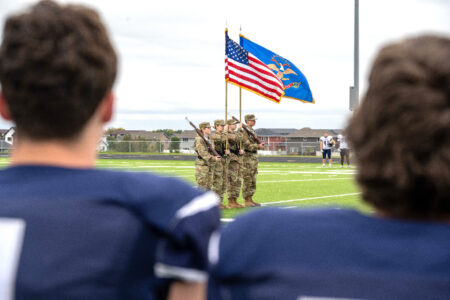What are American flag do’s, don’ts?

Submitted Photo Lois Schaefer, senior vice president of the Veterans of Foreign Wars Auxiliary Department of North Dakota, gives a presentation about flag etiquette to second-grade students at Bottineau Elementary School on May 19.
BOTTINEAU – Lois Schaefer, Bottineau, senior vice president of the Veterans of Foreign Wars Auxiliary Department of North Dakota, gives presentations about American flag etiquette.
Earlier this week, she gave a presentation to second-graders at Bottineau Elementary School, discussing the the do’s and don’ts and how to salute, including remove your cap, stand at attention, stop talking, place your right hand over your heart until after the flag passes by or the National Anthem is over. Each student received a small American flag.
Following are American flag do’s and don’ts she has prepared for her discussions.
Display the flag from sunrise to sunset on buildings and on stationary flagstaffs. The flag can be displayed 24 hours a day if it is properly illuminated during the hours of darkness.
Hoist the flag briskly and lower the flag ceremoniously.
Face the flag and stand at attention, stop talking, remove your cap, and salute the flag by placing your right hand over your heart when the flag passes by in a parade, during the ceremony of hoisting and lowering the flag, when reciting the Pledge of Allegiance, and during the performance of the National Anthem. If the flag is not displayed during the performance of the National Anthem, face the music and act in the same manner as if it were displayed.
Display the flag on state and federal holidays, anniversaries of states and other days as may be proclaimed by the president of the United States.
Fly the flag at half staff until noon on Memorial Day, then raise the flag to full staff.
By order of the president, fly the flag at half-staff upon the death of principal figures of U.S government, governor of a state, territory or possession.
Properly dispose of the flag when it is so badly torn, soiled or faded that it is no longer an appropriate emblem for display. A torn flag may be mended if it does not change the dimensions, a soiled flag may be washed or dry cleaned. Flags to be disposed of can be dropped off in a community disposal box often located at a courthouse or veterans building. The preferred choice for disposal is to burn the flag during a flag burning ceremony. The fire must be large enough to completely burn the flag to ashes. The flag is first folded in the customary triangular fold. As the flag begins to burn, the flag is saluted, the Pledge of Allegiance recited, followed by a moment of silence. The ashes are buried.
When the flag is displayed horizontally or vertically against a wall, the union should be uppermost to the observer’s left.
Do not fly the flag with the Union down.
Do not display the flag on days of inclement weather, unless the flag is an all-weather flag.
Do not carry the flag flat or horizontally, always carry it aloft and free.
Do not let the flag touch the ground, floor, water or anything beneath it.
Do not dip the flag to any person or thing.
Do not use the flag for clothing, costumes, athletic uniforms, bedding, drapery or a ceiling cover.
Do not use the flag for advertising. It should not be embroidered or printed on anything that will be used temporarily and discarded, such as cushions, napkins, paper plates, etc.
Do not draw or write on or mark the flag in any way.
Do not use or store the flag in a manner in which it could be easily torn or damaged.
The American flag is more than just cloth and red, white and blue colors that we see. Our flag embodies the principles, history and the men and women who have sacrificed so much to make the United State of America what it is, the land of the free and the home of the brave.




